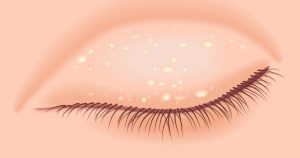How to Get Rid of Whiteheads on Your Eyelids
August 13, 2018 · 7:34 pm

Ever notice small white or yellow bumps under or on your eyelids or on your nose or cheeks? Those stubborn bumps are technically called milia, tiny cysts that form under the skin.
Treat Your Postmenopausal Osteoporosis
Milia develop when bits of dead skin cells "get trapped below the skin and create a really hard, little, white ball," says Neil Alan Fenske, MD, professor and chair of the department of dermatology at the University of South Florida Morsani College of Medicine in Tampa. Inside the cyst is keratin, a protein in both skin and hair.
Milia can grow up to two millimeters in size, but they're often smaller. And while they can develop in anyone, the bumps are most common in newborns.
"About half of infants will have milia, usually presenting on the face," says Nkanyezi Ferguson, MD, clinical assistant professor of dermatology at the University of Iowa Carver College of Medicine. "In newborns, the milia will usually resolve on their own within four weeks without need for treatment and without scarring."
Milia in adults are much the same, although they may last longer. In both cases, milia are essentially harmless and usually don't need treatment.
RELATED: Everything You Need to Know About Eyelid Bumps
So what causes milia?
No one really knows what causes milia to appear or why some people get more of the bumps than others. Some reports suggest that using harsh or heavy skin products can cause milia.
Milia may also be associated with other health conditions, certain medications, and skin trauma, like burns, rashes, dermabrasion, and even tattoos. In these cases, the resulting bumps are called "secondary milia" and can appear anywhere on your body.
"Milia can develop in an area following a blistering process or superficial ulcers from either trauma or procedures," says Dr. Ferguson.
This includes certain rare blistering diseases like porphyria cutanea tarda or epidermolysis bullosa. "When blisters heal, little remnants [of skin] get trapped in there," says Dr. Fenske.
A similar process happens with some sunburns. "We'll see some milia as skin peels off and little bits of epidermis get trapped," he explains.
Drugs that might contribute to milia include tyrosine kinase inhibitors, which treat different cancers, and strong corticosteroids.
RELATED: How to Fix Crow's Feet, Dark Circles, and More
How to get rid of milia
Milia don't need to be treated, and they usually go away within a few weeks to months. But you may want to get rid of the bumps sooner for cosmetic reasons. Like any other skin abnormality, don't pick at a milium (the singular form of milia). That'll only make it worse.
The only guaranteed way to get rid of milia is to see a dermatologist for an extraction.
"They really are stuck to the skin," says Michele S. Green, MD, a dermatologist with Lenox Hill Hospital in New York City. "Nothing but an extraction would remove them."
Smart skincare is important, but it won't get rid of milia. Not cleansing properly doesn't cause milia, says Dr. Fenske.
Steaming your face–say, sitting in the bathroom with the shower running very hot–may help soften the outer surface of milia so a dermatologist can remove them more easily. "Steaming can open a pore, but it's not going to get rid of milia," says Dr. Green.
Some people try home remedies like rose water (it's thought to be anti-inflammatory) or Manuka honey (also thought to be anti-inflammatory as well as antimicrobial), but there's no evidence these help. The same goes for exfoliation and chemical peels. In fact, these could make milia worse.
There's some evidence to suggest that vitamin-A-derived drugs called retinoids may help. "If many milia are present, your doctor may recommend a topical retinoid to reduce the number and to make removal easier," Dr. Ferguson says.
RELATED: Here's How to Get Rid of Those Tiny Red Bumps on Your Arms
When to see a dermatologist
If you decide you really want to get rid of milia, see a dermatologist.
"Milia are benign and do not require treatment," says Dr. Ferguson. "A dermatologist can help make the diagnosis of milia if you are concerned about the appearance. A dermatologist can also help remove milia if they are irritated or if they bother you cosmetically."
In the dermatologist's office, removal is easy, adds Dr. Fenske. "They're very superficial, but you can't really squeeze them out. We can just take a tiny little blade, make a little nick in it, and flick it out."
How to Get Rid of Whiteheads on Your Eyelids
Source: https://hscweb3.hsc.usf.edu/dermatology/what-are-milia-and-how-do-you-get-rid-of-them/
0 Response to "How to Get Rid of Whiteheads on Your Eyelids"
Post a Comment